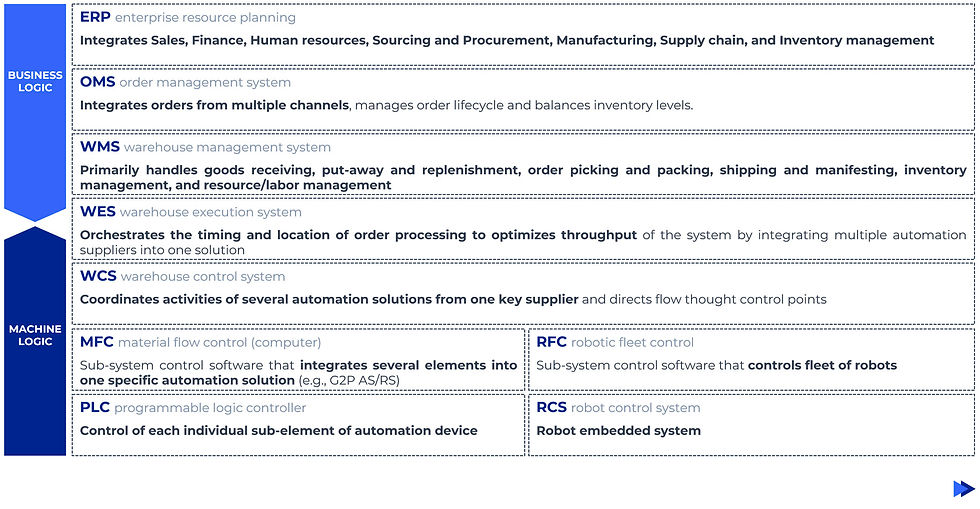Introduction
A modern warehouse equipped with automation is regarded as an ecosystem of interconnected IT solutions, each performing its unique task. Let's deep dive into what are these systems, how they all work together and what your business needs depending on the level of maturity.

As an example we will be reviewing the success story of a company that started as a manufacturer and grew into a vertically integrated distributor with a retail chain. Throughout the years there's been numerous automation projects that integrated together multiple systems such as WMS, MFC, WCS, WES... However, it all began with a single, straightforward solution - the AS/RS. Then there was a conveyor followed by implementation of AGVs. During the construction of the second manufacturing facility the company made a deal with one automation vendor that provided a turn-key solution covering equipment and IT aspects of the project. Finally, there was a decision to create an inhouse center of competence to manage smooth roll-out of automation projects.

Key IT systems for warehouse automation
Now, when the success story is clear, let's list down key IT-systems involved and their functions.

Enterprise Resource Planning (ERP) – A system that integrates Sales, Finance and accounting, Human resources, Sourcing and procurement, Manufacturing, Supply chain, and Inventory management with some limited warehouse management capabilities.
Order management system (OMS) – An application that integrates orders from multiple channels, such as B2B sales, inter-site transfers, retail and e-commerce. It manages order lifecycle and balances inventory levels. Can be a part of ERP or stand.
Warehouse Management System (WMS) – A software that primarily handles warehouse activities such as goods receiving, put-away and replenishment, order picking and packing, shipping and manifesting, inventory management, plus resource/labor management.
Warehouse Execution System (WES) – A solution that is deployed in highly automated systems. It is responsible for real-time coordination and prioritization of tasks, as well as the optimization of material handling workflow. It orchestrates order fulfillment, inventory management, and task allocation to various automated systems and human operators. It is used as a hub to connect multiple WMS solutions, multiple automation equipment (AS/RS, conveyor, AGV, robot) and multiple human interface devices (scanners, pick-to-light, put-to-light, scales...).
Warehouse Control System (WCS) – This software handles real-time equipment control, monitoring, visibility, routing, and optimization, ensuring the smooth and efficient movement of goods within one automation solution. It also provides interfaces between automation equipment and human interface devices.
Material Flow Control / Computer (MFC) – This system is a communication interface to multiple controllers (PLC) that as a sum represent simple automation solution, such as AS/RS (infeed/outfeed conveyor, crane and shuttle). It converts messages to formats recognized by different PLCs, optimizes automation sequence and manages the global state of the solution. It consists of a database, several parallel processes responsible for each element of automation and user interface for control, visualization and higher command execution (such as pallet/tote put-away or retrieval).
Programmable Logic Controller (PLC) – An industrial computer that manages one specific element of automation and executes specific functions. It consists of a power supply, data interface, input interface (sensors), output interface (motors), central processor, memory modules and control unit.
Robotic Fleet Control (RFC) – This system is a real-time status visualizer of the fleet. It controls multiple robots, provides battery status information, and consists of route planner, mission scheduler, traffic manager, mission manager, dynamic mapping, real-time fleet tracking, event/alert manager.
Robot Control System (RCS) – It is a robot embedded system that consists of a mission database, navigation module, motion module, perception module and cognition module.
Evolution of warehouse execution systems (WES)
The requirement to control and orchestrate multiple automation solutions combined with the shift towards waveless picking in retail and e-commerce business enabled the development of the warehouse execution systems. At first, automation companies started to add more WMS features to their WCS solutions and software companies introduced more machine interfaces to their WMS solutions. Then, the resource utilization orchestration features were added, and two types of WES emerged on the market:
eWES - embedded warehouse execution systems, developed by WMS companies
cWES - warehouse control execution systems, developed by OEM suppliers
Later, supplier agnostic solution integrators joined the competition and developed true middle-layer WES solutions that focus solely on orchestration tasks.

It is worth mentioning that the US market model with the strong level of competition and tendency to pick the best of the breed solution currently stands one step ahead of Europe which historically used turn-key solutions from single OEM supplier responsible for integration.
Judging on our practice, we believe that a stand-alone WES solution is required only if your company wants to break both ties to a specific automation supplier and to a specific WMS provider. This model will allow your organization to have execution consistency across different sites with varying automation requirements. But it will require a strong effort to create an in-house competence center.
Accentis team.


Comments